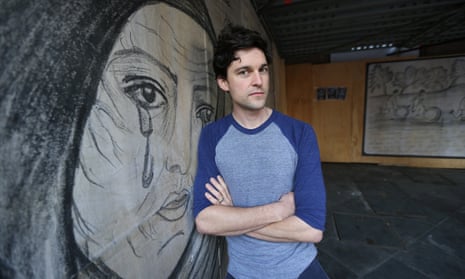On a wall down a quiet side street between North Terrace and Rundle Mall in Adelaide is a large poster the colour of parchment.
Printed on it is beautiful Arabic calligraphy with an English translation that reads: “My deep sigh tells me that the sky is cloudy today! Whether I accept it or not, wide oceans stand between me and my family.”
Abdul Rahman hasn’t seen it. But the 24-year-old English language student says he has seen the other paste-up across the street that tells the story of a refugee girl and her sister playing in the rain.
“I’ve shared it on Facebook,” Rahman says.
“They talk about real life and people, what they face. It really makes the city more beautiful.”
A couple of blocks over, Cheree Pertini is on her smoke break and standing in a nook just off Coromandel Place.
She says she hasn’t seen the other two images just around the corner either, but her eyes light up when she tells me about the one with the jacaranda tree just off Currie Street. She says it sticks in her memory.
“I think it’s a very interesting story. We see them all the time and don’t appreciate that it’s a new thing for refugees.”
All are the work of Adelaide street artist Peter Drew, who made his debut in 2011 when he took 42 police mugshots from the 1920s, blew them up to 2.5 metres tall and pasted them on walls across the city.
His latest project uses 36 images to tell the stories of refugees and asylum seekers, both in detention and on bridging visas, and puts them up on walls all over Adelaide.
The project has not totally escaped controversy. Several posters have been taken down after complaints to the Adelaide city council by building owners. While the council has expressed support for street art, it says that, as Drew did not ask for permission, its hands are tied where there has been a request for removal.
"They’ve been as supportive as they legally can be," said Drew.
"They agreed not to remove the posters that property owners haven't complained about, which is the way it should be for all street art. And the Public Arts Officer is organising a wall to put the pieces on for a longer period of time. They own plenty of walls around the city, so they’ll find something."
Drew says the idea for the project first came last year when he was at the Glasgow School of Art studying for a Master of Research in Creative Practices.
“It started last year during the elections when both major parties were saying ‘stop the boats’,” said Drew.
“Being away from Australia I started to think about what it really meant to be Australian.”
He then designed a poster that satirised the “stop the boats” slogan by tying it into to Australia’s colonial history.
“One thing that sticks with me is the courage and sacrifice of the people who came here by boat,” said Drew.
“Courage and sacrifice are supposed to be Australian values. The risks they endure, the hardship they endure, they understand more about what early colonial people went through than any of us.”
The idea for the project then expanded to include work made by refugees living in detention.
Drew would visit a family in South Australia’s Inverbrackie detention centre, one at a time, to bring them pencils and paper.
“I originally wanted to do portraits or photographs, but you can’t take the equipment in,” said Drew.
“It was all a lot of pot luck, really. What I was looking for is one family member who really loved to draw.”
“It’s a great deal of responsibility,” said Drew.
“You meet whole families and you hear their stories. Every story I heard reinforced the feeling that what I was doing had to be done.”
One of his contributors is Ali Reza Mohammad, an 18-year-old ethnic Hazara whose family fled Afghanistan for Quetta in Pakistan after his father was killed.
But they quickly learned that they were not safe in Pakistan, as violence against the Shia Hazara minority grew worse with the intensity of each new bomb blast. So, at the age of 16, Mohammad left behind his mother and two younger siblings to head for Australia to escape the violence.
He ended up making it to Australia by boat and spent four and a half months in detention centres on Christmas Island and in Tasmania, but is now out in the community on a bridging visa.
“My story is very sad,” said Mohammad.
“It happened to me and my family but it already happened. I can’t change that. What I care about is other Hazara.
“We want to tell the world our story. We want to live life. We don’t want to die.”
When asked of his family still in Pakistan, Mohammad says they are scared and that he worries about them.
“When something happens on the news, I always think about them. But I can’t change that. I can’t bring them here,” said Mohammad.
“In future, maybe God will help us.”
Mohammad says he “never” wants to go back and hopes his artwork will not jeopardise his visa.
Mostly, Mohammad says, he just wants to tell the story of his people. While he was not involved in Drew’s work inside the detention centre, he contributed 20 sketches to Drew’s project after the pair met at a community picnic on Australia Day.
Some of the most powerful of his images sit at the corner of Hindley Street and King William, each telling a different chapter of Mohammad and his family’s story.
At the bottom of one panel, someone has written in green marker: “Adelaide is lucky to have you.”

Comments (…)
Sign in or create your Guardian account to join the discussion